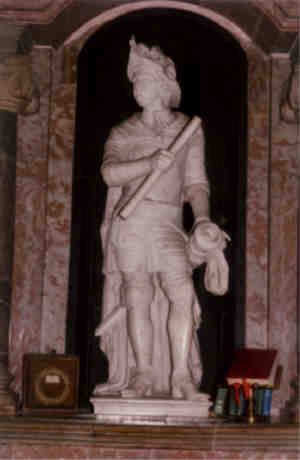Sir Robert Holmes 61
- Born: 1622, Ireland
- Partnership: Grace Hooke
- Died: 18 November 1692, Englefield Green, Surrey aged 70
- Buried: November 1692, Yarmouth, Isle of Wight

 General Notes: General Notes:
Of Mallow, County Cork.
Admiral, Governor of the Isle of Wight (1622 -1692)
Third son of Henry Holmes of Mallow, County of Cork, and brother of
Sir John Holmes, he served during the civil war in the Royalist Army
and, after the death of Charles I, in the semi-piratical 'squadron' of
Prince Rupert. In both army and naval activities he favourably
distinguished himself; but when he saw that the Royal cause could no
longer be supported by arms, he offered his services to foreign
souvereigns. Again he highly distinguished himself in France, Germany
and Flanders, attaching himself to the Duke of York.
After the restoration of Charles II he was rewarded in October 1660
with the Governorship of Sandon Castle in the Isle of Wight. About
the same time he sailed for the Guinea Coast for the protection of
trade from where he brought back the gold from which Guineas were
first minted. He was appointed to command 'Bramble', 'Henrietta' and
later the 'Royal Charles'. A minor incident with the Swedish
Ambassador plus a taste for flamboyant dress earned him the disfavour
in the diaries of Pepys who had a 'natural fear of being challanged'
by Holmes.
Towards autumn of 1663 he was appointed to the 'Jersey' and sent to
the coast of Africa to support the Royal African Company there against
the encroachment of the Dutch. After taking possession of several
Dutch settlements there (Gorre, Cape Coast, Aga, Annamaboe etc.) he
crossed the Atlantic in August 1664 to oust the Dutch from Niew
Amsterdam, which in English hands beame New York.
Consequent of representation made by the Dutch, he was committed to
the Tower; however, his detailed narrative warranting his conduct
earned his release on 6 March 1665 and on 23 March he received 'a
general pardon and release for all felonies and offences in England or
elsewhere'. But the blame for the war that followed is frequently
laid on Holmes. If his narrative is true, he acted with judgment,
prudence, skill and courage; but the 'facts' as described by
Valkenburg, Dutch Governor of Elbina on whom Holmes laid the chief
blame, are scarcely recognisable as the same.
Holmes was then appointed Captain of the 'Revenge', one of the White
Squadron under Prince Rupert in the action off Lowestoft on 3 June
1665. From the reputation he acquired here, he requested promotion to
the Flag of Rear Admiral of the White, vacant by the death of Sansum,
but was denied in favour of Harman. Consequently he handed his
Commission to the Duke who tore it up. Despite his behavior,
described as that of 'a rash, proud coxcombe...he is rich and sought
an occasion of leaving the Service', he was appointed to the
'Defiance' while still on the stocks before being launched on 27 March
1666. The king (with the Duke of York and Prince Rupert) was present
at the ceremony and conferred on Holmes the honour of knighthood.
When the fleet was remodelled on 30 May 1666, Holmes was nominated
Rear Admiral of the Red over Harman who remained Rear Admiral of the
White. Further appointments and action brought him both renown and
disfavour, even to as far as the king ordering a Court Martial, but
which resulted in the matter being referred back to the king and a
duel ensuing between Holmes and Admiral of the Blue Squadron, Sir
Jeremy Smyth. Holmes was falsely reported to have been killed, for
soon after the king conferred upon him an honourable augmentation to
his arms: the English Lion in a Canton; and as a crest: a naval
crown, out of which an arm in armour bearing a trident.
In 1667 Sir Robert Holmes was returned to Parliament as Member for
Winchester. He was also appointed Captain-General and Governor of the
Isle of Wight where, at Yarmouth, he had built a large mansion. There
he entertained the king in 1671, 1675, and 1677 with 'regal
magnificence', which would seem to confirm Pepy's statement of his
being rich. Still further appointments and action ensued, his career
bound with the Duke of York's tenure of office as Lord High Admiral,
particularly in the war against the Dutch.
His later life was passed in the duties of his office as Governor of
the Isle of Wight and as Member of Parliament, in which he sat almost
continuously for Winchester, Yarmouth or Newport. (Newport - 1678,
1685, 1689-90; Yarmouth - 1688-89) In July 1690, after the battle of
Beachy Head, he was despatching intelligence of movements of the
French Fleet.
His will dated 28 October 1692 described him then as in perfect
health; and thus, without any long illness, he died on 18 November
1692. He was buried in Yarmouth Church where there is an ornate
monument to his memory.
It appears that he never married; therefore he had no legitimate
children and, by his will and after making an ample provision for an
illegitimate daughter (Mary Holmes), he devised the bulk of his
property to his nephew, Henry, son of his elder brother, Thomas Holmes
of Killmallock, County Limerick, subject to the condition that he
marry the illigitimate daughter within eighteen months. This marriage
duly took place and resulting in many children which included Thomas,
1st Baron Holmes of Killmallock, and Admiral Charles Holmes.

 Noted events in his life were: Noted events in his life were:
1. Promotion: 1660, Captain.
2. Promotion: 1661, Rear Admiral Of A Detached For.
3. Promotion: 1666, Rear Admiral Of The Red.
4. Knighthood: 27 March 1666, Deptford, London.
5. Promotion: 1667, Admiral Of A Detached Force.
6. He signed a will on 28 October 1692.
7. He had an estate probated on 19 November 1692.

Robert had a relationship with Grace Hooke.
|

 General Notes:
General Notes: